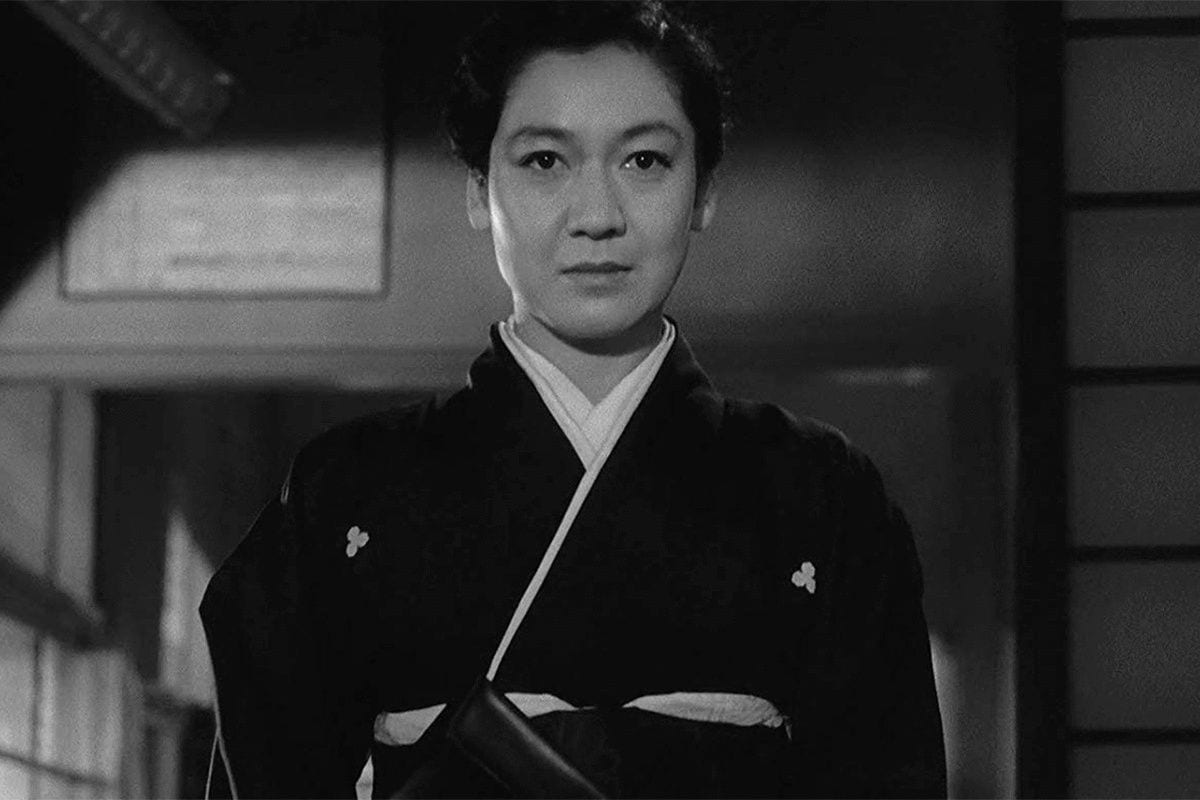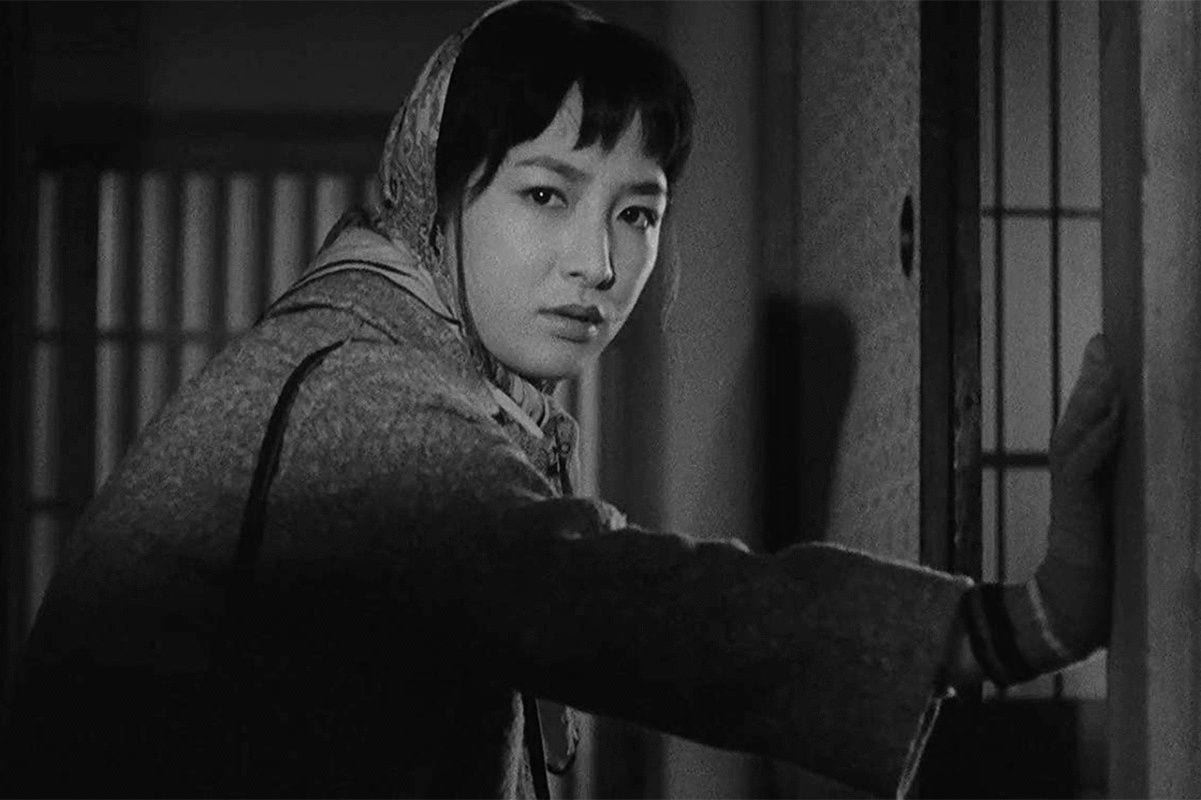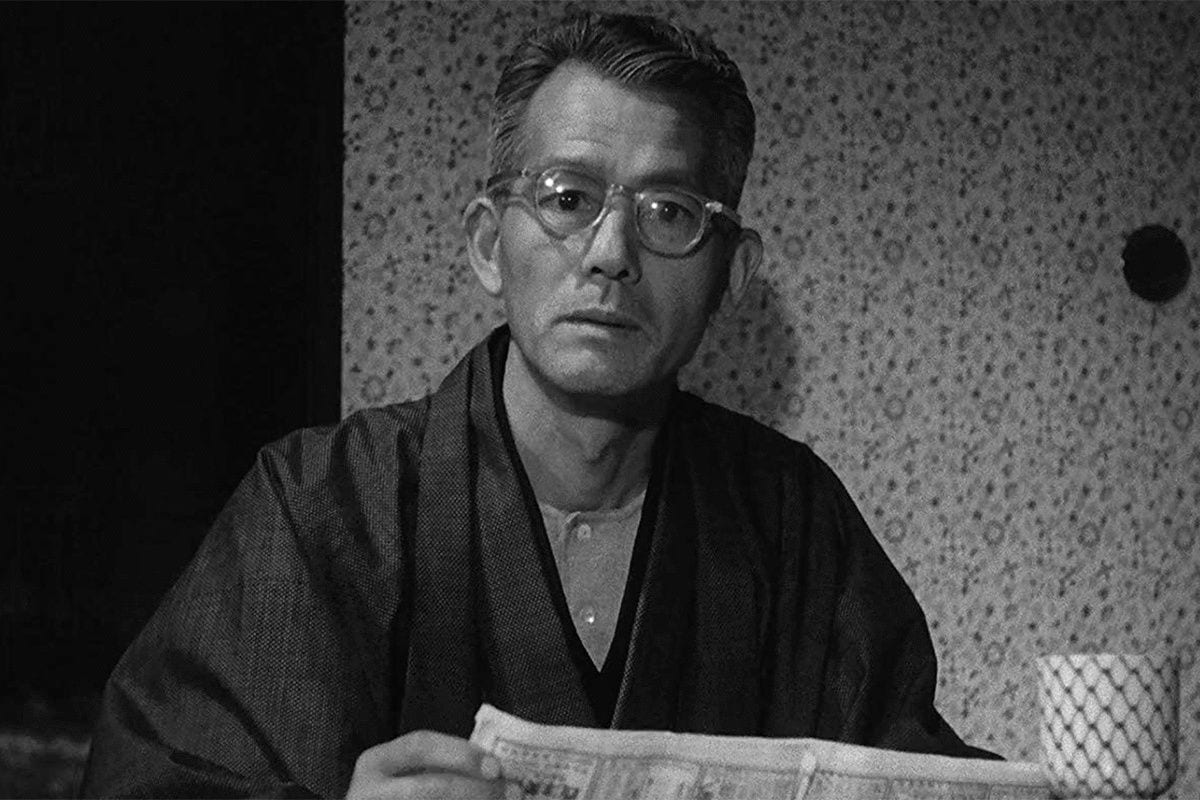Tokyo Twilight marks the apogee of Ozu’s exploration of the tension suffusing a stillness that attempts to deny or allay personal misery.
Rarely shown and generally considered one of his darker films, 1957’s Tokyo Twilight (Tôkyô boshoku) epitomizes two of Yasujirô Ozu’s most compelling contributions to cinematography: his ability to tap into the profound meaning of stillness and his reversal of the power of the gaze. The story concerns a banker Shukichi (the Ozu regular Chisû Ryû) and his two daughters. The elder daughter, Takako (Setsuko Hara, one of Ozu’s most versatile and quietly intense actresses), has left her alcoholic husband and returned to her father’s home with her infant child.
Shukichi realizes that Takako suffers, in part, because he encouraged her into an arranged marriage with a professor rather than allowing her to marry for love (more in accord with emergent post-war values). His younger daughter, Akiko (Ineko Arima), discovers she is pregnant; her callous boyfriend dodges her attempts to discuss the crisis and her friends ridicule her for what they mistakenly regard as foolish love-sickness.
The family is haunted by the betrayal and abandonment of their mother, Kisako (Isuzu Yamada), who left Shukichi for another man and never saw her daughters again. Kisako has now returned to Tokyo to run a mahjong parlor. Takako learns that their mother is nearby and wants to prevent Akiko from discovering their connection to her. And yet, Akiko suffers, in part, because she feels she belongs to no one. She feels estranged from her father, who wants to help her but seems to only be able to deal with her moodiness through mild scolding; she feels the bitter absence of a mother that she never truly knew.
With a plot grounded in romantic turmoil, familial betrayal and distrust, and strained relationships among three people who love each other but feel disconnected, one might expect Tokyo Twilight to be replete with bravura performances, fraught and embittered arguments, and brutal irruptions of anger and resentment. Aside, however, from a few scenes of tense extroversion, all involving the tortured and confused Akiko, Tokyo Twilight presents a muted emotional palette that belies and focuses the suffering experienced by the three protagonists.
Smoke by werner22brigitte (Pixabay License / Pixabay)
For viewers unfamiliar with Ozu, the tonal register of the film might appear somewhat flat and underplayed. For advocates of his understated style, Tokyo Twilight marks the apogee of Ozu’s exploration of the tension suffusing a stillness that attempts to deny or allay personal misery.
There is a paradox to stillness in this world. Indeed, true stillness would be to negate the world. For the world exists and existence entails endurance through time. Time is the measure of motion and thus without motion there is no time. There is one exception: the Divine, at least under the conception of Divinity as atemporal. For thinkers such as Augustine and Aquinas in the western tradition, or the Laozi of the Tao Te Ching in the eastern tradition, the Divine exists but is outside of time. The Divine is unchanging and eternal. Time emerges from the timeless, the motions of the world arise from the immobility of the Divine presence. Stillness in this world, stillness as we experience it, therefore always points beyond itself toward the placidity of the Divine.
And yet, in this world, stillness bears a furtive relationship to motion; silence holds noise within it. No matter how quiet of an environment you find or cultivate, noise lurks there. John Cage once described entering an anechoic chamber where he believed he would experience true silence. He heard two sounds: a low murmur and a high crackling sound. The engineer working at the chamber informed him that the former was the blood coursing through his veins while the latter was his nervous system in operation. There is no ultimate silence for us in this world; the world constantly produces sound, no matter how small or how discreet.
Moreover, we seem to find some simulacrum of stillness even amidst noticeable noise. Think of the low hum of a bus engine as you are conveyed to your destination in the depth of night. The engine is not silent and yet it offers a kind of stillness within its omnipresent drone. Drones and elongated or gently repetitive sounds are often used in meditation practices to arrive at an experience of stillness.
So, in one sense, stillness is impossible in the world; in another sense, we experience stillness despite its absence. Stillness becomes a way of attending to the world but it is also a way the world has of revealing itself. Neither entirely subjective nor objective, stillness draws us out into the world and it invites the world into our interior selves. Yet, within that stillness constant agitation remains, however dulled, however attenuated.
No director seems more attuned to stillness in all of its manifest contradictions than Ozu. The most obvious approach to capturing the meditative and revelatory power of stillness in his films is the use of the stationary camera. In Ozu’s work, the camera rarely moves; there are precious few tracking shots. Often, a scene begins in an empty space, the camera positioned low; a character enters the frame but all movement takes place within the stationary framework of that shot. Ozu will allow cuts between shots, particularly when filming conversations, but each time the shot returns to a given character, the former set-up returns.
One might be tempted to view this as a bid for objectivity. The camera in Kurosawa or Hitchcock often takes on an agency all its own. Think of the moments in Hitchcock’s films where the camera explores a space on our behalf without there being any grounded subject in the film whom we are tracking (the sleeve ripping scene in Saboteur (1942) is but one example among many). The camera is our surrogate; we are in the act of discovery, as though our desires, our agency guides the camera’s movements.
Ozu establishes a point of view and then we are only privy to whatever enters that perspective. If an object or another person blocks our view of the main character, no adjustment is made; partial and obstructed views suffuse the Ozu film. Characters enter and leave the scene; we rarely follow. When Ozu does want us to remain with a character in motion, he generally establishes a new set-up, a new point of stability before which the character moves. The camera’s immobility perhaps refutes the illusion of our participation in the narrative (the illusion exploited by Hitchcock). We occupy a limited and limiting space, privy only to a restricted view of his filmic world.
Setsuko Hara as Takako Numata (IMDB)
One of the most striking aspects of Tokyo Twilight is the way in which the frontal shot provides such poignantly differing impressions of the main characters.
One of Ozu’s favorite strategies is to employ architecture as a frame and impediment to our act of witnessing the unfolding drama. Consider the establishing shots that initiate so many scenes in Tokyo Twilight. In the first interior scene, we are placed at the far side of a café, facing the entrance. A man sits at the counter sipping sake; the woman who runs the café is behind the bar, but nearly entirely obscured by a wall that connects to the counter. Shukichi enters and he and the proprietress converse amiably. Shukichi is partially blocked by the other customer from our view and the proprietress remains almost totally hidden.
It is an odd way to film the opening of a conversation. It restricts our view of the participants in the dialogue, forcing our focus onto a character who seems entirely superfluous to the moment and on a wall that impresses negative space onto our field of vision. Such shots suggest that this is not our world; we have no place here aside from articulating the quiet power of place itself. The characters will come and go; they will find joy and misery; they will converse and fall silent. Other people will arrive and leave; businesses change hands. But the place remains the same, witnesses all things that pass, taking a stake in nothing.
And yet, objectivity hardly seems to be the point in Ozu. The reserve with which the actors fill their roles ought not to be mistaken for a clinical dissection of their characters and actions. The stationary camera, oddly, strikes filmgoers as artifice. The active camera (this subjective force that bears no subjectivity beyond our own, or the director’s) appears the more natural. Hence, there is something gently disruptive about Ozu’s gesture. But it does not remove our subjectivity from the film. Rather, perhaps surprisingly, it reorients it. Instead of actively navigating our way through the world via the camera’s seemingly independent actions, we remain unmoved and the characters come to us, appeal to us, reveal themselves to us. The revelatory quality of the stationary camera comes most clearly into focus in the noted frontality that Ozu employs in capturing his protagonists.
Consider the most characteristic shot in an Ozu film. The camera is placed low, at about the level of the head of a seated person. The character sits directly before the camera staring directly into it. In Tokyo Twilight, there are several moments in which the father Shukichi converses with another character. He delivers his lines with the gentle exactitude that imbues so many of Ozu’s characters. We see his face and upper body squarely framed in the shot. We occupy the space of his interlocutor; in some scenes his eyes are trained slightly to the side of us, in others they disconcertingly seem to capture our own gaze. In a very real sense, he speaks directly to us. But his body is framed in the manner of an icon painting. It appears almost unreal.
Rarely do we see (in life or in film) such utter frontality; there is always an angle to relieve the severity of the implacably flat spatiality of the frontal view. Even portrait paintings in the Medieval period (when Byzantine icon paintings of the Virgin and Jesus were common) often employed a side view; in the Renaissance, of course, painters frequently employed the three-quarters view. Stark frontality is almost oppressive, frighteningly revelatory, and thus generally reserved for the Divine or the noble. (The uncanny aspect of frontality may be why it makes such a striking reappearance in Surrealist painting.)
Perhaps the unsettling nature of frontality involves the sense that we are no longer the one in charge of the gaze. Instead of looking at an icon painting, we can’t shake the feeling that it is looking at us, that we are being seen, and perhaps judged. A portrait involving a subject who looks to the side (even if only slightly) allows us the safety of observation without being ourselves observed. We might feel somewhat removed from the subject qua subject. That is, the person in the portrait makes no demand on us; she allows herself to be seen qua object: an object of desire or merely of curiosity, but an object all the same.
A portrait or a camera set-up in film that invokes frontality creates a subtly confrontational image and an image that promises revelation. This is why, in other contexts, the “breaking of the fourth wall” in film often involves frontality. Think of Alvy Singer’s (Woody Allen) direct address to the audience in the opening of Annie Hall (1977). It is a comedic gesture of a narrator adumbrating the moral behind his reflections on a failed love affair: life is paradoxically miserable and too short, and relationships are doomed to fail when we can’t allow ourselves to “belong” to another. Alvy delivers the oration directly to us; he is here to tell us his story and acknowledges us as his audience.
The Ozu gesture has an entirely different affective impact. The characters are not guiding us so much as revealing themselves to us, perhaps reticently, but in a manner that does not always readily accord with the dialogue they deliver. Indeed, one of the most striking aspects of Tokyo Twilight is the way in which the frontal shot provides such poignantly differing impressions of the main characters.
Ineko Arima as Akiko Sugiyama (IMDB)
Stark frontality is almost oppressive, frighteningly revelatory, and thus generally reserved for the Divine or the noble.
Akiko always appears on the verge of an outburst, her rage at an unfair world barely concealed. Her eyes flash and yet behind them lies a knowing pain, a suspicion that there will be no rest for her. Takako appears to be hiding some aspect of her emotional life. Even in those moments where she seems to be unguarded, something is held in reserve, as though she sees no reason to reveal any more than is necessary. In conversation with her father, particularly, her eyes suggest a world of thought never expressed, a depth of pain she wishes to remain untouched.
Shukichi’s frontal shots are staggering in their revelatory power. Indeed, the communication of spiritual profundity that transcends any present concern (no matter how vexing) seems to be a specialty of the actor Chisû Ryû. Shukichi often simply utters the equivalent of “uh huh” in response to questions and observations, and yet the calm and gentle delivery of this expression points beyond the narrative moment to that underlying stillness that Ozu seeks. Not unlike the author of Ecclesiastes, Ozu suggests that “all is vanity” in the sense of “futility”. The world continues on and we within it struggle for a moment or two and then pass away. What we leave behind soon vanishes after us. In light of our inability to create something enduring within it, this world can easily appear to defeat human purpose. In Ecclesiastes, this realization leads the author to contemplate the justification of despair.
Yet the author finds justification for the world by looking beyond the world. Meaning, in Ecclesiastes, doesn’t derive from what happens within the world; the production of meaning cannot derive from worldly means. Rather, we occupy ourselves properly in this world by reference to the beyond, to the divine. Now, the toil (so much lamented in Ecclesiastes) of the man who seeks worldly justification for it and the toil of the wise man who looks beyond the world will appear no different to any observer.
The difference between the two is internal; it is a felt difference experienced by the worker. The joy one derives from worldly activity is the manifestation of an inner stillness, an assurance that the divine sets forth a goodness that may not be entirely discernible from within this world. And yet it is a goodness that suffuses all things—even those we do not currently desire or appreciate, even those that make us suffer.
Chishû Ryû as Shûkichi Sugiyama (IMDB)
Ozu’s films make a similar move with an important difference. That stillness that Shukichi exudes belies the turmoil he experiences in the narrative; his calm registers despite the concern he feels for his two troubled daughters. Even in the most wrenching moments of despair, that calm remains. Ozu recognizes, like the author of Ecclesiastes, that all of this will pass all-too-readily and all-too-soon to relatively little effect. And yet, the meaning of all these moments of loss and joy transcends the events themselves. The events aren’t meaningful in their own right; they are a reflection of a meaningfulness that doesn’t change.
Events are fleeting; change appears constant. But Ozu’s films alert us to the notion that the truth beyond the world doesn’t change; that truth is permanent, truth is stillness. And it flickers forth in all these happenstances—the joyful and the tragic.
This assurance, however, comes across in the disposition of Shukichi before the camera, seated before us, looking into our eyes, capturing our gaze. Herein lies the difference between Ozu and Ecclesiastes. We are asked to bear witness to Shukichi’s inner calm. He reveals it to us. In Ozu, the difference between the fool who ricochets from moment to moment and the wise man who sees the meaning of this world conferred upon it by the beyond is apparent; it is a difference that can be seen but not spoken.





